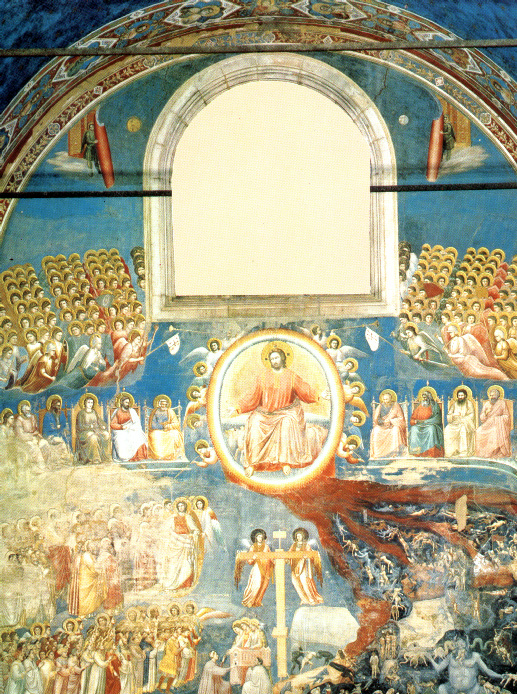Faith and Reason: intimate tensions.
![]()
The centrality of Christ as the pathway to salvation in the high middle ages is depicted in a fresco by Giotto but informed by the creed which the artwork seeks to didactically portray.

The Last Judgment, Giotto di Bondone, fresco in a Chapel in Padua. 1307.1
The concept of a final accounting of human lives is an enduring concept that is associated with a theme stretching back to the sense of morality depicted in the Old Kingdom of Egypt and depicted on tombs and in the Book of the Dead. Christianity's emergence in Egypt and often its refuge in Alexandria are doubtless reinforcing experiences that could have led to the adoption and subsequent proselytizing of this belief in and hope for some final judgment of dead souls. In an otherwise unjust, unfair, and violent world this expression of hope in some ultimate reckoning for justice and truth may be the most human of tensions between reason (balance or harmony) and faith (trust in enduring correctness). In each of these three renderings the use of perspective is absent or repressed, as in Michelangelo's Sisitine wall fresco.
The last judgment portrayed here from an Egyptian tomb showing Anubis the Jackal headed God and the balance scale, attended by the Baboon headed deity. The portrayal reveals a dead soul being interrogated by weighing the misdeeds of the deceased person against the weight of a feather. The impression from these inscriptions suggests that a common belief was widespread: humans are accountable for their actions and must be measured like a commodity of trade before being admitted to paradise by the guardians of the underworld. Death then is but a weighing of the livings' mummified heart.
Anubis is among the oldest of Egyptian deities associated with the dead, the journey through the hall of judgment and final rest in the underworld. He allegedly feeds the hearts of the wicked to Ammit the alligator headed god who eats the evil organ after Anubis had weighed these hearts against the mass of an Ostrich feather. The criteria that is implicit in the visualization of the judgment is the underlying concept of Ma'at. Both a goddess and a concept, Ma'at literally is translated as "that which is straight" but by implicit associations with measurement she (and the ideal) embodies cosmic order derived from harmony, balance, and by extension, justice or truth. She comes into existence as the God Ra emerges from waters of chaos an allusion to the annual flooding of the Nile.
Anubis is actually the Greek name for the Egyptian God Anpu, or Inpu from the Old Kingdom texts and tombs. The God acts as a guide to the underworld in among the oldest extant texts. Associated with the weighing of souls from the oldest hieroglyphics. (the Pyramid text of Unas from the Egyptian Liturgy of the Dead) comes the line " pay attention to the decision of truth {balance, harmony} and the plummet of the balance (scales) according to its stance." 2
Post Reformation fresco in the Vatican's Sistine Chapel.
On the wall forming the backdrop of the altar in the Sistine Chapel in Vatican City, Michelangelo painted the last judgment during the time when the Protestant Reformation swept across western Europe influencing the creation of national churches centered on the use of the vernacular (national languages) and the authority of the bishops. The painting differs from the style, mood and message of Giotto's and the Egyptian tomb shown above.
Michelangelo, the Last Judgment, 1530s. Fresco in the Vatican.
This wall fresco was "painted by Michelangelo between 1536 and 1541. The imagery "is centred around the dominant figure of Christ, captured in the moment preceding that when the verdict of the Last Judgement is uttered (Matthew 25:31-46)." 3
"from whence he will come to judge the quick and the dead" 4
a line from the Roman & Lutheran translations of Nicene Creed.
Giotto | Egyptian tomb | Michelangelo
1) Giotto di Bondone, Arena (Scrovegni) Chapel, Padua, 1304-1305 - Part 4 of 4 (The Last Judgment)
Suggested influence by the: The Book of Revelation. 20:1-15.Giotto lived in or near Florence in roughly the years from 1267 – to 1337.
2) Papyrus of Ani, 18th Dynasty - Chap.30B, pl. 3.
3) from the Vatican guide on-line.
4) The Christian Book of Concord: Or, Symbolical Books of the Evangelical Lutheran Church. Edited by Ambrose Henkel, Socrates Henkel. Newmarket: Henkel Brothers, 1851. pp. xix-xx.
Video on Giotto's work by the Kahn Academy.
Video on Michelangelo's fresco in the Vatican on the Second Coming.
The restoration of the Vatican fresco examined.